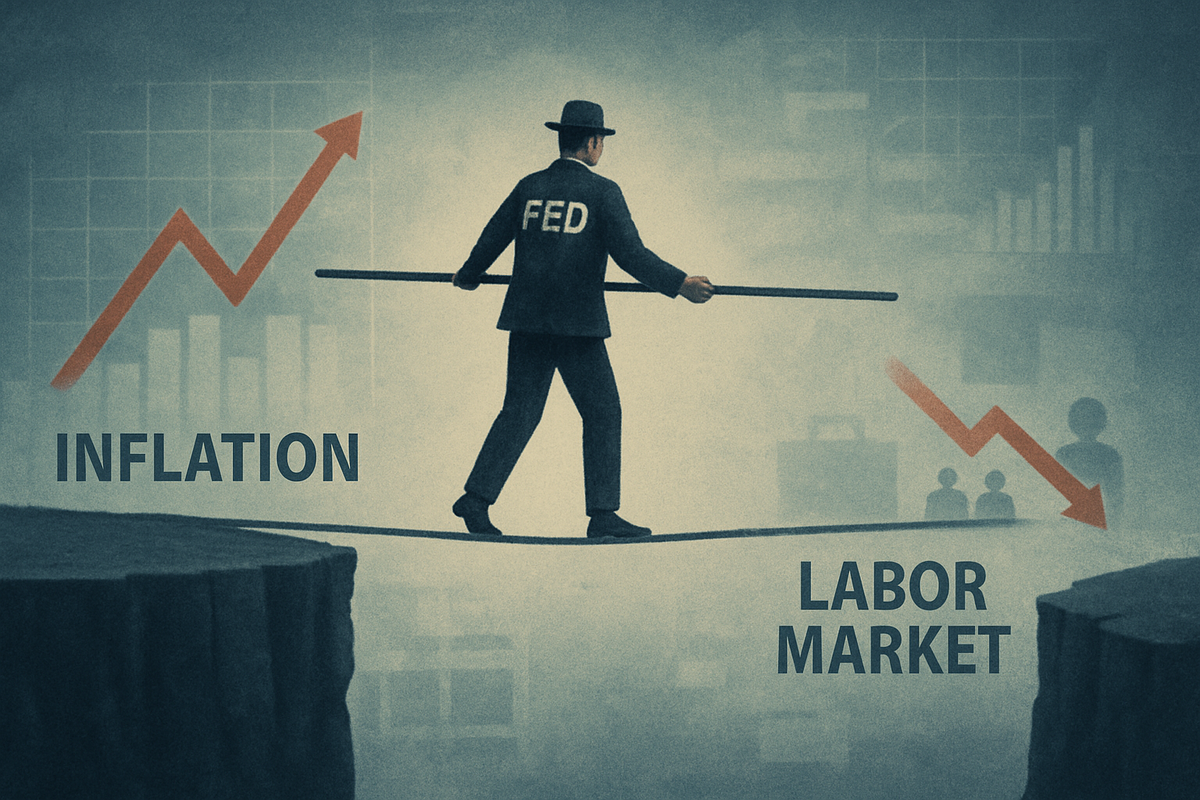
As October 2025 draws to a close, the financial markets are intently focused on the Federal Reserve's delicate balancing act: taming persistent inflation while supporting a softening labor market. Recent economic data, though partially obscured by an ongoing government shutdown, paints a picture of moderating, albeit still elevated, inflation alongside a discernible weakening in employment figures. This complex scenario has solidified the Fed's dovish pivot, with interest rate cuts in September and October signaling a clear prioritization of economic growth and employment stability, even as consumer confidence wanes under the weight of stubborn prices. The immediate implication for markets is a continuation of an easing monetary policy cycle, which could influence everything from borrowing costs to corporate earnings in the coming months.
The Fed's Tightrope Walk: Data Delays and Dovish Decisions
The current economic landscape is characterized by a series of critical indicators, some of which are subject to delays due to the government shutdown, creating a "data blackout" for policymakers. The Consumer Price Index (CPI) for September 2025 registered a 3.0% year-over-year increase, slightly above August's 2.9% but a hair below forecasts, with core CPI also at 3.0%. This figure, released primarily for Social Security adjustments, indicates inflation remains above the Fed's 2% target. The Personal Consumption Expenditures (PCE) price index, the Fed's preferred gauge, showed headline inflation at 2.7% year-over-year in August, with core PCE at 2.9%. Preliminary estimates for September suggest a slight uptick in headline PCE, but official data remains elusive.
Crucially, the labor market is showing signs of distress. The U.S. unemployment rate climbed to 4.3% in August 2025, the highest since October 2021, reflecting an increase of 148,000 unemployed individuals. Long-term unemployment has surged to 25.7% of all jobless individuals, a level often associated with or preceding economic downturns. The September jobs report, a vital piece of the economic puzzle, has been postponed. Despite these labor market concerns, the GDPNow model by the Federal Reserve Bank of Atlanta estimates robust real GDP growth for Q3 2025 at an annualized rate of 3.9%, though official government reports are also delayed.
In response to these developments, the Federal Reserve executed a 25-basis-point interest rate cut in September 2025, followed by another in October, bringing the federal funds rate target range to 3.75%-4.00%. These cuts, the second and third since December 2024, were largely anticipated by markets. The Fed's "dot plot" from September projects two more 25 bps cuts in 2025, with further reductions expected in 2026 and 2027. This aggressive "dovish pivot" underscores the Fed's growing concern over the softening labor market, suggesting the employment mandate is currently outweighing the inflation target. While economists note that rising tariffs are contributing to some goods price increases, the Fed largely views this as a "one-time price shock."
Corporate Fortunes: Winners and Losers in an Easing Cycle
The Federal Reserve's shift towards an easing monetary policy will inevitably create a divergence in fortunes across various sectors and public companies. Lower interest rates generally translate to reduced borrowing costs, which can stimulate investment and consumer spending.
Potential Winners:
- Real Estate and Construction: Companies like D.R. Horton (NYSE: DHI) and Lennar Corporation (NYSE: LEN), as well as real estate investment trusts (REITs) such as Simon Property Group (NYSE: SPG), stand to benefit significantly from lower mortgage rates, which can boost housing demand and make commercial property investments more attractive.
- Consumer Discretionary: Retailers and companies selling non-essential goods and services, such as Amazon (NASDAQ: AMZN) and Starbucks (NYSE: SBUX), could see increased consumer spending as borrowing becomes cheaper and disposable income potentially rises.
- Growth Stocks: Technology companies and other high-growth firms that rely on future earnings potential often perform well in lower interest rate environments, as their future cash flows are discounted at a lower rate, increasing their present value. Companies like Microsoft (NASDAQ: MSFT) and NVIDIA (NASDAQ: NVDA) could see renewed investor interest.
- Financial Institutions (with caveats): While lower rates compress net interest margins for banks like JPMorgan Chase (NYSE: JPM) and Bank of America (NYSE: BAC), the increased demand for loans (mortgages, personal loans, business credit) spurred by cheaper borrowing could offset some of this pressure. Mortgage lenders, in particular, could see a surge in refinancing and new loan applications.
Potential Losers:
- Bond Investors (Income-focused): While existing bonds might see their values rise as new bonds offer lower yields, investors seeking high, stable income from fixed-income securities might find it harder to achieve their targets with persistently low rates.
- Companies with High Export Exposure (if dollar weakens): If lower U.S. interest rates lead to a weaker dollar, companies that primarily export goods could see their products become more expensive for international buyers, impacting sales for manufacturers like Caterpillar (NYSE: CAT).
- Sectors reliant on strong pricing power: While inflation is still present, a cooling economy might make it harder for some companies to pass on increased costs, potentially squeezing margins for businesses that have benefited from recent pricing power.
Wider Implications: A Shifting Economic Paradigm
The Federal Reserve's current policy trajectory fits into a broader global economic narrative characterized by persistent supply-side challenges, evolving labor market dynamics, and geopolitical uncertainties. The softening U.S. labor market, despite historically low unemployment, points to deeper structural shifts, including slowing job creation and declining labor force participation. This trend, coupled with ongoing consumer concerns about inflation, could signal a more protracted period of economic adjustment.
The ripple effects of the Fed's dovish stance extend beyond domestic borders. A sustained easing cycle in the U.S. could influence global capital flows, potentially leading to a weaker U.S. dollar, which would have implications for commodity prices and the competitiveness of U.S. exports. Regulatory bodies will also be closely monitoring the housing market and financial stability, ensuring that lower rates do not fuel excessive risk-taking or asset bubbles. Historically, periods of aggressive Fed easing have often followed significant economic shocks or periods of sustained high unemployment, such as the post-2008 financial crisis era. While the current situation isn't as dire, the Fed's proactive cuts suggest a similar preventative approach, aiming to avert a deeper downturn. The ongoing government shutdown further complicates this picture, delaying crucial data and creating a "cloudy view" for both policymakers and market participants, making informed decision-making more challenging.
What Comes Next: Navigating the Path Ahead
The immediate future points towards continued monetary easing by the Federal Reserve. Market expectations are for another quarter-point rate cut in December, aligning with the Fed's September "dot plot" projections for two more cuts in 2025. This trajectory suggests that short-term interest rates will likely remain suppressed, aiming to stimulate economic activity and support the labor market.
In the short term, businesses and consumers can expect lower borrowing costs, which could encourage investment, mortgage refinancing, and consumer spending. However, the stickiness of inflation, particularly consumer expectations of higher prices, remains a critical challenge. For investors, this environment presents both opportunities and risks. The bond market may continue to see demand as investors seek yield, while certain equity sectors, particularly those sensitive to interest rates like technology and real estate, could perform well. However, the potential for a weakening dollar and persistent inflation could also pose challenges, requiring strategic portfolio adjustments. Long-term possibilities include a gradual return to the Fed's 2% inflation target, potentially leading to a more normalized monetary policy stance, or, in a less favorable scenario, a prolonged period of stagflation if inflation remains elevated while growth stagnates. Strategic pivots for businesses might include focusing on cost efficiencies, supply chain resilience, and adapting to evolving consumer spending patterns shaped by inflation concerns.
A Balanced Act: Summary and Future Outlook
In summary, the Federal Reserve is navigating a complex economic landscape characterized by moderating but persistent inflation and a softening labor market. The Fed's recent interest rate cuts in September and October 2025 signal a clear prioritization of its employment mandate, initiating an easing cycle despite inflation remaining above its 2% target. Key takeaways include the resilience of GDP growth estimates, the concerning rise in unemployment, and the critical role of consumer sentiment, which continues to be weighed down by inflation expectations.
Moving forward, the market will remain highly sensitive to upcoming economic data, particularly the delayed jobs and inflation reports, which will provide crucial clarity. Investors should closely watch for further signals from the Federal Reserve regarding its future policy trajectory, including any revisions to its "dot plot" projections. The interplay between inflation, employment, and interest rates will define the market's direction in the coming months. Companies that can adapt to lower borrowing costs and potentially increased consumer spending, while managing inflationary pressures, are likely to thrive. The overarching theme is one of cautious optimism, as the Fed attempts to engineer a soft landing amidst lingering economic uncertainties.
This content is intended for informational purposes only and is not financial advice





